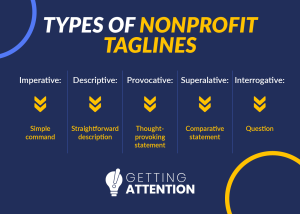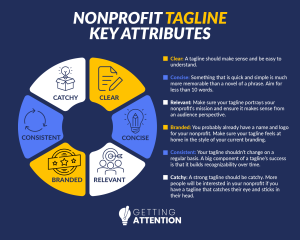Getting Your Nonprofit Tagline Right: Top Tips and Examples
Taglines are the quickest and most efficient way in your marketing strategy to tell people about your nonprofit’s mission. In one short phrase, you can tell your audience who your organization is and why they should care.
Think about Nike’s “Just Do It” or Little Caesar’s “Hot ‘n’ Ready” – these taglines give the brands more energy and character. A great tagline can work the same magic for your nonprofit.
Even though they are an incredibly useful tool, taglines are overlooked in the nonprofit world. In this guide, you’ll learn about taglines and how to write one for your mission-driven organization. Here’s what we’ll cover:
- What is a nonprofit tagline?
- Do nonprofits have taglines?
- What makes a good tagline?
- Top Nonprofit Taglines
Read on and you’ll be ready to create a clear, concise, and catchy tagline for your nonprofit in no time.
What is a nonprofit tagline?
A tagline is a short, memorable phrase that succinctly captures a brand’s message. Once it becomes well known, a tagline also acts as a way to easily identify the brand it represents. Specifically for a nonprofit organization, a tagline should communicate its mission and purpose.

5 Types of Taglines
There are five types of taglines that are commonly seen in the nonprofit marketing sphere:

- Imperative: Imperative taglines command the audience to do something. They usually begin with a verb and involve an action relevant to the brand’s message. Coca Cola’s “Open Happiness” is an example of an imperative tagline. Subtly assertive, this type of tagline can give your brand a quality of urgency.
- Descriptive: This is the most straightforward type of tagline. Descriptive taglines concisely describe the brand’s promise or function. Think about Walmart, which is known for low prices. Its tagline is “Save Money. Live Better.” This phrase clearly yet simply explains Walmart’s primary function.
- Provocative: Despite what the term suggests, provocative taglines don’t have to be shocking, per se. Rather, these taglines ask a question or offer a statement that provokes thought. Dove’s tagline “You are more beautiful than you think” is a prime example of a provocative tagline.
- Superlative: Named for the highest degree of comparison, superlative taglines position a brand as the best in its industry. Budweiser is known as “The King of Beers,” BMW is known as “The Ultimate Driving Machine,” and Gillette is known as “The Best a Man Can Get.” Each of these brands is establishing itself as the superior product within its product category.
- Interrogative: Interrogative taglines ask the audience a question. One of the most famous taglines ever is an interrogative tagline — the California Milk Processor Board’s “Got Milk?”
A quick note: Taglines are not the same as slogans. A tagline is one phrase for the overarching idea of an organization. Slogans, on the other hand, accompany specific marketing campaigns. An organization could have multiple slogans for many different campaigns, but it will only ever have one tagline at a time.
Do nonprofits have taglines?
The short answer to the question of if nonprofits have taglines is yes, they do have taglines. However, seven out of 10 nonprofits rated their tagline as poor or didn’t have one at all. That means they’re not nearly as abundant as they should be.
If you fall within that seven out of 10 designations, it’s worthwhile to reevaluate your nonprofit’s tagline strategy. Here are three benefits to having an effective tagline for your mission-driven organization:
- Differentiation: Consumers see between 4,000 and 10,000 advertisements daily. Having a standout tagline can help your nonprofit break through the noise and make a connection with a new potential supporter.
- Branding: Brands typically consist of a name, logo, colors, fonts, and—you guessed it—a tagline. A strong nonprofit tagline will give your organization extra support in terms of brand recognition.
- Consistency: Since taglines capture the heart of your nonprofit’s mission, they can serve as a guiding element for your future campaigns. You can always revisit your tagline when making marketing plans to be sure you’re in line with your nonprofit’s core mission and brand identity.
With the combined advantages of differentiation, high-quality branding, and consistency, your nonprofit marketing will become much more recognizable. Not only will this make you stand out from the crowd, but it can also give you a leg up in the digital marketing space.
For example, you can maximize programs like the Google Ad Grant with an impressive nonprofit tagline. If your nonprofit’s tagline conveys a particular sentiment or mission, the Google Ads funded by the Ad Grants can reflect the same message. This consistency then reinforces your organization’s brand and mission to potential donors, volunteers, and beneficiaries.
Interested in learning more about the Google Ad Grant program? Check out this video:
Now that you know the benefits of a stellar nonprofit tagline, let’s break down the criteria necessary to achieve one.
What makes a good tagline?
Coming up with a phrase that represents the entirety of your nonprofit in eight short words (or less!) is no easy task. Luckily, we’ve compiled a list of characteristics that will make your tagline stand out from the rest. We’ve also got the steps you can take when you start the process of drafting your own.
6 Attributes of a Strong Tagline
Let’s start with the attributes of a strong tagline:

- Clear: A tagline should make sense and be easy to understand. Think about using a navigation app for directions—you want your tagline to simply and surely show people what your nonprofit is about the same way that GPS tells you how to get somewhere.
- Concise: The shorter a tagline is, the better. Something that is quick and simple is much more memorable than a novel of a phrase. Aim for no more than eight words.
- Relevant: Make sure your tagline portrays your nonprofit’s mission. It might make sense to you, someone who is close to the nonprofit, but think about it from your audience’s perspective. Will someone who has never heard of your brand get the gist of your nonprofit’s purpose from reading its tagline? If not, you should head back to the drawing board.
- Branded: You probably already have a name and logo for your nonprofit. Make sure your tagline feels at home in the style of your current branding. Also, going back to the idea of differentiation, your tagline should be identifiable as yours specifically.
- Consistent: Your tagline shouldn’t change on a regular basis. A big component of a tagline’s success is that it builds recognizability over time. Put your tagline on all your brand materials and make sure it looks the same every time, including in its punctuation and capitalization.
- Catchy: Finally, a strong tagline should be catchy. More people will be interested in your nonprofit if you have a tagline that catches their eye and sticks in their head.
Get creative, and write something memorable while also accurately representing your mission.
5 Steps to Coming Up With Your Very Own Tagline
Your nonprofit needs to know what it’s aiming for before diving in, but be open to where the brainstorming process takes you. Here are our five steps for writing a tagline:
- Begin with the end in mind. Before diving into actual tagline writing, ask yourself some key questions about your nonprofit, such as: What is our core mission and purpose that we want to communicate? And Where do we want our nonprofit to be in five years?
- Consider emotions. Different words conjure up different feelings, moods, and connotations. The words you choose for your tagline are no exception. Choose words that align with the emotions and ideas you want your organization to project.
- Come up with many, many options. In the brainstorming phase, no idea is a bad idea! Even if some of the taglines you come up with would never make the final cut, it’s a great exercise to figure out what you like and don’t like, then move forward.
- Don’t overthink your final decision. A tagline can be bad, and a tagline can be good—but you’d be hard-pressed to find a tagline that is faultless. It’s a subjective process, so work hard and once you arrive at a phrase you’re happy with, stick with it!
- Research examples. This isn’t to say model your tagline completely after someone else’s, but rather that you should use examples as inspiration. Even for-profit resources like Adobe’s list of 30 famous taglines can help you gain creative traction.
Keep in mind that a tagline is one part of your nonprofit’s overall marketing plan. For your tagline to be relevant it needs to make sense within the context of your organization and its overarching audience and goals.
Top Nonprofit Taglines
So far, we’ve given you some examples of memorable taglines in the for-profit space. Now we’ll provide you with some nonprofit taglines—ones that are more similar to your organization.
Here is a list of 12 strong nonprofit taglines organized by the size or vertical of the nonprofit:
Global Nonprofits
These examples come from organizations whose mission extends to the entire world. Check out their taglines for clear illustrations of how to condense such a large concept into eight words or less.
- “Open hearts. Open minds. Open doors.” – The United Methodist Church
This tagline is simple, meaningful, and memorable. The repetition sticks in people’s heads, and the welcoming nature of the writing reflects what this organization is about. According to its website, the mission of the United Methodist Church is “to make disciples of Jesus Christ for the transformation of the world.” With its tagline, the church is communicating that it is open to all people joining its mission.
- “For every child.” – UNICEF
An even better example of simplicity, UNICEF’s tagline clocks in at three words and expresses what UNICEF is about at its core: working toward the “survival, protection, and development” of children all across the world, according to its website.
Nonprofits of this size need worldwide recognition, and they utilize taglines to help achieve it.
U.S. Nonprofits
Although these examples come from nonprofits slightly smaller than those of the former examples, their taglines feel equally as strong. Read on to see how national nonprofits tackle taglines:
- “A mind is a terrible thing to waste” – The United Negro College Fund
The United Negro College Fund “envisions a nation where all Americans have equal access to a college education that prepares them for rich intellectual lives” and works to increase the total number of Black college graduates in the U.S., according to its website. This tagline provokes thought relevant to the organization’s mission, calling on their audience to ponder how valuable people’s minds are—and subsequently, consider what they can do to encourage educational growth.
- “Holding power accountable” – Common Cause
Every word in this tagline holds enormous weight in the message it’s conveying. Common Cause is a nonprofit that exists to ensure the United States’ democracy fairly serves all its constituents, and it does so by fighting for pro-democracy legislation like the recent Freedom to Vote Act. Their tagline succinctly expresses that sentiment— and it has a serious tone that matches the organization itself, too.
The United Negro College Fund and Common Cause are excellent models for provocative and descriptive taglines, respectively. Think about which type would best fit your nonprofit.
Local Nonprofits
Now we’ll look at nonprofits that while small in size, have taglines that feel larger than life.
- “Big sky. Big land. Big history.” – Montana Historical Society
Just because this nonprofit operates in a smaller area doesn’t mean its tagline is any less impactful. The Montana Historical Society describes itself as a “guardian of Montana’s history,” a history that this tagline appealingly illustrates as an expansive one full of sky and land.
- “Driving out hunger in Atlanta, one mile at a time.” – Second Helpings Atlanta
Second Helpings Atlanta is a locally based nonprofit that fights both food insecurity and food waste in the metro Atlanta area by delivering leftover food from restaurants and grocery stores to food banks and individuals in need. This tagline is on the longer side, yet it remains memorable and clearly depicts what SHA volunteers do: drive leftover food from somewhere that doesn’t need it to someone who does.
Healthcare Nonprofits
Because health-related missions can be sensitive and require swift support, these organizations must use their tagline to build trust and form an emotional connection. Let’s review how these top healthcare nonprofits use their tagline’s language to inspire compassion and credibility:
- “Finding cures. Saving children.” – St. Jude’s Children Research Hospital
St. Jude is “leading the way the world understands, treats, and defends childhood cancer and other life-threatening diseases” through advancing cures and prevention. The organization has been around since 1962 and dreams that no child should pass before the dawn of life.
St. Jude’s descriptive tagline gets right to the heart of its purpose. The simple phrase discusses how the organization uses its funding and why people should care.
- “Every tomorrow should have you in it.” – American Cancer Society
The American Cancer Society is a leading cancer-fighting organization dedicated to ending cancer for everyone. They seek to improve the lives of people with cancer and their families through research, advocacy, and patient support.
This tagline provokes a sense of hope that aligns with the American Cancer Society’s positive tone. Previous campaigns such as “the official sponsor of birthdays” have contributed to the organization’s upbeat determination to beat the disease for good.
Environmental Nonprofits
Nonprofits dedicated to protecting the environment need taglines that will inspire hope and drive others to join in protecting that hope. Additionally, many environmental nonprofits cover several different initiatives, so their tagline can’t box them in. Let’s review how the World Wildlife Fund and Sierra Club structured their taglines:
- “For a living planet” – World Wildlife Fund (WWF)
For 60 years, WWF has helped both people and animals thrive in nearly 100 different countries. The organization collaborates with communities to develop and deliver lasting solutions to wildlife problems. WWF’s work extends into climate, food, freshwater, forest, ocean, and other wildlife-related initiatives to achieve a thriving planet.
WWF’s tagline captures these ambitious goals by staying descriptive yet being all-encompassing. Because the WWF has several goals, using “planet” rather than “community” or “wildlife” shows that each solution is interconnected and will ultimately benefit the whole planet.
- “Explore, enjoy, and protect the planet” – Sierra Club
The Sierra Club is a grassroots organization located in the United States that exists to defend everyone’s right to a healthy world. Their work promotes the responsible use of the earth’s ecosystems and resources in addition to educating others about protecting the environment.
The organization’s descriptive tagline goes beyond just suggesting that we should protect the planet just for protection’s sake. Rather, it suggests that the planet is worth protecting because it’s where we explore and enjoy life.
Human Rights Nonprofits
By nature, human rights Nonprofits carry heavy emotional undertones. To strike the right chord with their taglines, they must inspire action without digging too deeply into negative emotions. Both Amnesty International and CARE do a stellar job at this:
- “It’s not enough to be outraged” – Amnesty International
Amnesty International is a global movement that campaigns against human rights abuse. The organization’s initiatives include topics such as child rights, climate change, police brutality, international justice, and many more campaigns created to achieve justice.
This provocative tagline implies that Amnesty International wants to turn sympathetic feelings into action. The organization’s robust research advocacy, lobbying, and campaigns were created and funded to make change happen.
- “Defending dignity. Fighting poverty.” – CARE
CARE works globally to save lives, defeat poverty, and achieve social justice. Specifically, the organization focuses on aiding women and girls in need and advocating for equal rights opportunities. Their work spans climate, food and water, health, education and work, and equality-related goals to offer a better life of dignity and security.
CARE’s inclusion of dignity within its tagline speaks to its hope of restoring the integrity of others. Its transformative programs act as a pathway to an enriching life.
Wrapping up
A strong, well-written tagline can elevate your nonprofit’s brand and marketing efforts. We hope this article has been helpful to you in learning what a tagline is, why they’re important, how to create a great one, and what examples are out there.
Getting Attention can also help take your marketing strategy to the next level, especially in getting your brand new tagline to the top of Google’s search results. Get a free consultation today!
Here are three extra educational resources to help boost your nonprofit marketing strategy:
- A Winning Nonprofit Marketing Plan: How to Make People Look: Your tagline is just one small piece of your marketing puzzle. Learn how to fit your entire marketing plan together with this comprehensive guide!
- Digital Marketing for Nonprofits Made Easy: A Helpful Guide: Are your online marketing efforts as strong as they can be? Fortify your digital marketing with strategy tips from this guide.
- The Ultimate Guide to Marketing Grants for Nonprofits: Marketing expenses can take up to 15% of a nonprofit’s budget – you can alleviate some, if not all, of that financial burden with free money in the form of grants. This article will give you the scoop on all the best grants out there, and how to get them.






